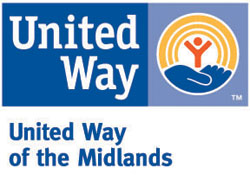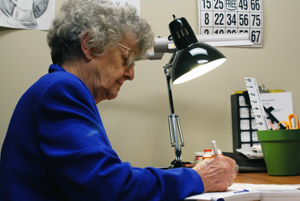 Imagine not being able to recognize familiar faces because your vision is fuzzy. Picture reading a magazine, but letters are missing. Envision trying to call a friend, but the numbers on the dial are a blur. That’s what macular degeneration is like.
Imagine not being able to recognize familiar faces because your vision is fuzzy. Picture reading a magazine, but letters are missing. Envision trying to call a friend, but the numbers on the dial are a blur. That’s what macular degeneration is like.
“We live in a sighted culture and take for granted being able to see,” said John Shepherd, M.D. ophthalmologist and director of UNMC’s Weigel Williamson Center for Visual Rehabilitation. “When people can’t see well, it erodes their sense of independence and they may feel depressed and despondent.”
That’s exactly how Joan Sackett of Columbus, Neb. felt prior to being referred to the center for visual rehabilitation a couple months ago.
 |
Joan Sackett of Columbus, Neb., has learned how to live independently with macular degeneration thanks to the help she receives at UNMC’s Weigel Williamson Center for Visual Rehabilitation. UNMC employees can write in the center for their choice of organizations to support with their United Way donations. |
It all started when Sackett began seeing black spots about three years ago. Soon after, she was diagnosed with macular degeneration. According to Dr. Shepherd, macular degeneration is the No. 1 cause of irreversible vision loss in individuals older than 55 in this country. Other common causes include diabetic retinopathy, glaucoma and stroke.
Dr. Shepherd’s job at the center for visual rehabilitation is not to repair or restore lost vision. His patients cannot be helped with stronger prescription glasses, medications or surgery.
“But there are still things that can be done,” Dr. Shepherd said. “I assess the quantity and quality of patients’ remaining vision and teach them to use that sight as effectively and efficiently as possible to enjoy life activities.”
His arsenal of devices includes a Craftsman toolbox full of not wrenches, but magnification tools. His most valuable tool, however, is his time. Dr. Shepherd spends at least an hour with each of his patients assessing their needs.
In Joan’s case, Dr. Shepherd discovered that she already owned a magnifier but didn’t use it. Many low vision patients have devices to help them with their vision but don’t use them because they don’t know how or because the devices are not the correct magnification strength.
Enter Evy Katz, the in-house occupational therapist at the center for visual rehabilitation.
“When a person has low vision, they have to learn to use their eyes in a different way,” she said. “I work with them on pinpointing ways they are able to see best with or without magnification to do their everyday activities.”
For Sackett, it’s by looking up and to the right rather than straight ahead. At a recent appointment, she was able to read a recipe card for sloppy joe’s and see and stay on the lines to write a letter using a bold line piece of paper and a black pen.
As someone who had not read for years prior to coming to the center for visual rehabilitation, which is not uncommon for those with macular degeneration, it was a sign of great progress.
I’m doing a lot better,” said Sackett, who now practices reading 15 minutes in the morning and 15 minutes at night, along with doing the homework she receives from Katz.
Based on what clients are able to do and their goals, Katz assigns worksheets with words games that help with reading comprehension in a way that’s challenging, but fun.
With the help of Katz’s visual training exercises and some lighting adjustments at home, Sackett is now able to read normal size print with a magnifier. She is excited to start reading her hometown newspaper, the Columbus Telegram, again and possibly some Mary Higgins Clark books.
She also is back in the kitchen cooking meals for her husband of 58 years, Bud. At the suggestions of Katz, Bud placed raised markers on stove knobs so Sackett would have a frame of reference for 350 degrees and high and low. Her 23-year-old granddaughter even took the time to type up her grandmother’s favorite recipes and made her a large-print cookbook.
The adjustments and adaptations have allowed Sackett to regain her independence, just as so many others who come to the center for visual rehabilitation do.
|
“It’s very gratifying and rewarding when you can help them continue doing activities that are meaningful to them.”
“I would say just about everyone who comes to the center leaves having learned something whether it be about lighting, contrast or low vision devices,” Katz said. “It helps them to know there is support out there for them and that they don’t have to struggle with vision loss alone. With the right adaptations, a lot can be done.”
But without donor support, none of it would be possible, said Dr. Shepherd, adding that there is a need to establish an endowment for ongoing expenses.
Those who would like to donate can do so by designating the Weigel Williamson Center for Visual Rehabilitation as their write-in agency for the United Way campaign.
Sackett encourages people to do so.
“It is a great place,” she said. “I had high hopes they were going to help me and they have.”